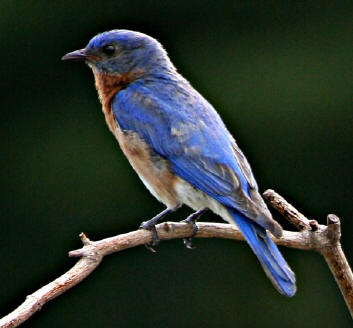 Congratulations for deciding to encourage the Eastern Bluebird to come to your yard! The beautiful harbinger of spring, with sky on it's back will bring you undeniable pleasure as you watch it courting, nesting and raising a family.
Congratulations for deciding to encourage the Eastern Bluebird to come to your yard! The beautiful harbinger of spring, with sky on it's back will bring you undeniable pleasure as you watch it courting, nesting and raising a family.
In the 1950’s, due to use of pesticides, several harsh winters in a row, the introduction of the English Sparrow and starlings along the eastern seaboard, and the loss of natural habitats from urban growth, almost 90% of the bluebird population were
eradicated. People like you, who have taken the time to put up nesting sites, have helped the bluebird population increase dramatically in the past few years.
Here are a few suggestions for you to make your habitat more successful.
- Limit pesticide use-bluebirds primary diet consists if insects, plus berries in fall and winter
- Plant berry producing trees and bushes.
- Proper nesting boxes - Purchase a true bluebird nesting box. Most garden centers have them for $12 to $20. I particularly liked the kind with a removable nest base in it. My birds used it, and I could lift the nest out easily to monitor.
- No perch! Perches encourage predators, and the birds don’t need them.
- Round opening 1 1/2"" diameter, or oval of 1 3/8 x 2 ¼ "
- Ventilation openings in top of box, drainage holes in bottom.
- Roof over-hangs in front.
- 5-7" from floor to opening.
- A way to open either top, front, or side to monitor. [side or front is best]
NOTE: Bluebird houses should be put up at the end of February or early March. I do have copies of plans to make them if you are interested.
Location:
- 200 yards apart if putting up more that one nesting box.
- Facing east or northeast –away from prevailing winds.
- Not in a wooded area or in a tree line but can be 50 to 100 feet from bushes.
- Place boxes 4 – 8 feet high—facing a clearing if possible.
- U poles/metal fence posts (about $6.00) are perfect for hanging bluebird-nesting boxes. PVC pipes work well too.
- Trees work, but not as well and I don’t think we can or should use telephone poles.
Monitoring:
The North American Bluebird Society has very strict guidelines for monitoring nesting boxes. I have included their address at the end of this article. You can write, call or pull up their web site address for this information. I personally think the
amounts of monitoring you do is up to your own preference and ability. At a minimum, be sure it is a bluebird using your box!! Sparrows and wrens like them too! English sparrow and starling nests should be removed and destroyed…any other birds you have to leave alone then
try a new site further from bushes for your box next season.
You can peek at your eggs and fledglings often---just don’t chill or drop them! You should know when the eggs are laid; especially the last one. You want to stop monitoring 13 days after the last egg is laid; less you scare the babies into early
flight. Give mom bluebird a little warning prior to opening the box. Look for signs of predators or damage. It’s really a thrill to watch these tiny birds develop. Once their eyes are open they will peek at you and then hide their heads. It doesn’t seem to bother any of
them, but do limit peeking to once a day, quietly.
Empty your boxes after fledglings have left. You can hose it out if you feel the need, but no sprays or soaps. Remember that bluebirds will have 2-3 broods per season, with little time in between!
What’s Happening at Your Bluebird Site?
- Mid-March to early April: courtship! Male finds site, woos female into accepting. May come back and look over site, then leave for days before returning.
- Mid-April: nest building for 5-6 days, mostly by female as male stands guard. Eggs laid (1 per day) for 3-6 days. Incubation begins the day last egg is laid, lasting 13-14 days.
- End of April: eggs hatch.
- 7-10 days later: eyes open, feathers developing.
- 20 days from hatching: fledglings leave nest, hide in nearby bushes, fed by parents.
- 1 week later: babies feed self with occasional help from male. Female starts new nest. Fledglings from the first brood will help feed babies from the second hatching.
Resopurces:
- North American Bluebird Society
P.O. Box 6295 Silver Spring, MD 20906
Web site: http://www.cobleskill.edu/nabs/
- The Bluebird Book by Donald and Lillian Stokes
- Bluebirds in My House by Arnette Heidcamp
Read other articles on birds, wildlife & beneficial insects
Read other articles by Judy Watt